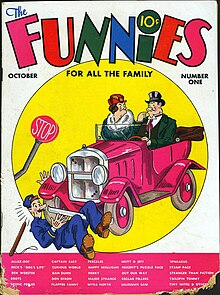The Funnies
| The Funnies | |
|---|---|
 The Funnies #28 (September 13, 1930), cover art by Victor E. Pazmiño (signed).[1] | |
| Publication information | |
| Publisher | Dell Publishing (Dell Comics) |
| Schedule | Varied between weekly and monthly |
| Format | Ongoing series |
| Publication date | January 16, 1929 – October 16, 1930 |
| No. of issues | 36 |
The Funnies is the name of two
The Funnies (1929–1930)
In 1929, George T. Delacorte Jr.'s Dell Publishing, founded eight years earlier, began publishing The Funnies, described by the Library of Congress as "a short-lived newspaper tabloid insert".[2] Comics historian Ron Goulart describes the 16-page, four-color, newsprint periodical as "more a Sunday comic section without the rest of the newspaper than a true comic book."[3]
The magazine ran 36 issues – originally weekly, then monthly from April 1929 to April 1930, and then weekly again – published Saturdays from January 16, 1929, to October 16, 1930.[4] The cover price rose from 10¢ to 30¢ with issue #3.[5] This was reduced to a nickel from issue #22 to the end.[5]
The Funnies helped lay the groundwork for two subsequent publications in 1933:
The Funnies (1936 to 1942) and New Funnies
| The Funnies | |
|---|---|
 The Funnies vol. 2, #1 (Oct. 1936), featuring Major Hoople of Gene Ahern's Our Boarding House, cover artist unknown. | |
| Publication information | |
| Publisher | Dell Publishing (Dell Comics) |
| Format | Ongoing series |
| Publication date | The Funnies: 1936–1942 New Funnies: 1942–1962 |
| No. of issues | 288 |
A rival to
The Funnies began running original material with Mayer's feature Scribbly, about a boy cartoonist, laid out to look like a Sunday
New Funnies
The comic book switched formats and title to become New Funnies with issue #65 (July 1942).
See also
References
- ISBN 978-1-888054-38-5
- ^ U.S. Library of Congress, The Funnies, "American Treasures of the Library of Congress" exhibition. WebCitation archive.
- ISBN 978-0060538163.
- ^ Funnies, The (Dell, Film Humor, Inc. [#1-2]; Dell Publishing Co. [#3-36] imprint, 1929 Series) at the Grand Comics Database
- ^ a b Coville, Jamie (n.d.). "The History of Comic Books: Introduction and 'The Platinum Age 1897 - 1938]'". CollectorTimes.com via TheComicBooks.com. Archived from the original on September 26, 2010.
- Toonopedia. "Foxy Grandpa".
- ^ Famous Famous - Carnival of Comics at the Grand Comics Database.
- ^ Goulart, p.144, for example, calls it "the cornerstone for one of the most lucrative branches of magazine publishing".
- ^ a b c d Goulart, Ron. "The Funnies: II" Comic Book Encyclopedia, p. 163
- ^ Funnies, The (Dell, 1936 Series) at the Grand Comics Database.
- ^ Don Dixon and the Lost Empire in Don Markstein's Toonopedia. Archived from the original on January 12, 2015. Some sources misspell the title of the accompanying strip as "Tad of the Tambark". As Markstein explains, tanbark "refers to bark used in tanning, which is also used to cover circus rings".
- ^ Norman Marsh at the Grand Comics Database.
- ^ Thomas, Roy (2018-02-21). Alter Ego #151. TwoMorrows Publishing.
- ISBN 978-1605490892.
- ^ New Funnies at the Grand Comics Database.
- ^ Walter Lantz New Funnies at the Grand Comics Database.
Further reading
- All in Color for a Dime by ISBN 0-87341-498-5
- The Official Overstreet Comic Book Price Guide by Robert Overstreet — Edition #35 ISBN 0-375-72107-X
- The Steranko History of Comics, Vol. 1 & 2, by ISBN 0-517-50188-0
External links
- The Funnies (1929) at the Grand Comics Database
- The Funnies (1936) at the Grand Comics Database
- New Funnies at the Grand Comics Database
- Walter Lantz New Funnies at the Grand Comics Database
- Dell Comics at Don Markstein's Toonopedia. Archived from the original on September 12, 2017.
- Multi-part discussion of The Funnies, particularly issue #34 (Oct. 4, 1930), Stripper's Guide
